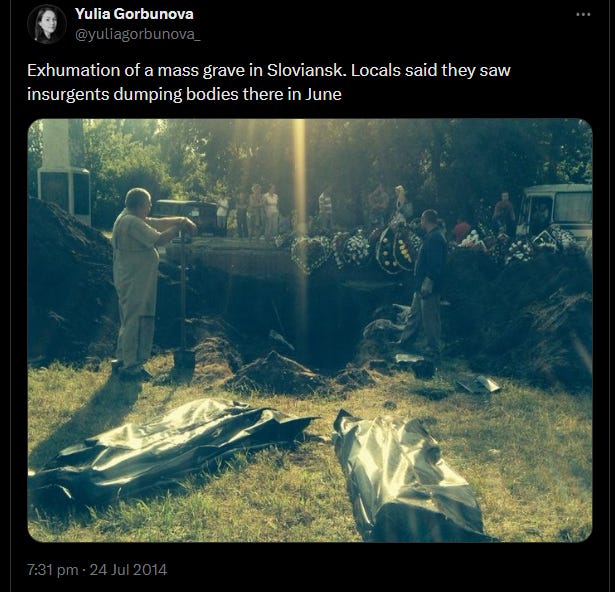People and Maps: What Happens to the Enslaved Ukrainians?
Are we ready to consign people to a Russian Hell?
I hold up my hands on this one.
I have no idea of what will happen concerning the touted meeting between US President Donald Trump and his Russian counterpart Vladimir Putin.
However, it is unlikely that they will organise a meeting unless they have agreed in advance some kind of beneficial outcome in which neither loses face.
Likewise, I am struggling with the optics of Putin’s decision to welcome US envoy Steve Witkoff to Moscow. Putin, usually incredibly shrewd in his machinations, must have considered the benefits of receiving yet again a mere bagman, and what he might get out of it.
These are enslaved people
I cannot say this enough, and other better people have also stressed this:
Any negotiation should focus on the people, not on maps. Or business deals.
Estimates range as to the number of Ukrainians under Russian enslavement, though it is likely to be over 3.5 million.
And I try to shun the phrases ‘Temporarily Occupied Territories’ or ‘Temporarily Controlled Territories’ and their associated abbreviations, as they only aid in the abstraction of what is happening under the Russians.
I also warn—as have others, more eloquently—of Russian attempts to dehumanise Ukrainians, deny them their agency or their history or their future.
Or of their individual lives.
So: how do the enslaved Ukrainians live?
Enslaved people and their hellish lives
These areas are not black boxes: there are ways of getting reliable information from people there, people with their families who were unable or did not initially want to leave.
Instead of writing off these people as somehow ‘Russian’ or abstractly destined to their fate, we need more research and better methodologies into understanding lives in these areas.
Existing understanding, though, still gives a wide and profound insight into how people live.
We also have access to networks of reliable people there who can share what life is like. And it seems hellish.
Conditions vary greatly across the various administrative areas. But these seem like degrees of torture.
The Russian approach to putinisation in Ukraine hinges on a range of techniques that come together strategically, and under that opportunistically: brutality, violence, fear, cognitive occupation.
Russian forces maraud, stealing, beating, occupying people’s homes and taking what they like.
In Kherson, there are frequent reports of Russian troops even fighting amongst themselves, especially the violent Chechen units.
In Donetsk, the water crisis worsens, with some people receiving scare supplies and collecting their water from puddles. The occupation administration has in effect ordered people to put up with it and to adjust to the new ‘realities’.
Video: Pensioners in Makiivka reportedly collecting water from puddles in the street, Tipichnyi Donetsk Telegram channel, 5 August
In Luhansk, people have told me of extreme violence used against Ukrainians, including rape.
And all over, the Russians have been executing people at will, with much evidence of murders and massacres since the invasion in 2014.
Image: Screenshot of tweet by Yulia Gorbunova. The photograph is reportedly Gorbunova’s
Signing off on a map consigns people to this: abandoning them to unadulterated putinism with impunity.
The Russian art of the deal
As I said above, I have no insight into Washington’s and Moscow’s plans as to what to do next. Trump will almost certainly be focused on presenting some kind of peace deal which he can tout for his desired Nobel. This is a severe vulnerability, as it gives the Kremlin room to prise and offer something that looks like peace.
Diplomatic deception was a key component of Soviet foreign policy. As Kerry M. Kartchner explains, the Soviet Union made diplomacy ‘an instrument, not for promoting and servicing an international system of diverse nation-states, but for pursuing war against that system’ (I can provide the source for anyone interested).
The Kremlin seems intent on continuing and intensifying that approach: it uses discourse not to exchange ideas, but as a weapon to weaken others and to promote violently its own policies. Woe to those who believe otherwise (I have been warning governments about this for years).
It is possible that Putin is trying to lock in Trump to negotiations and a deal. Russian state television presenters on the Vremya Pokazhet (Time Will Tell) political chat show today (7 August) were discussing in formal terms specific ‘buffer zones’: ‘the Sumy Buffer Zone’, and ‘the Kharkiv Buffer Zone’.
I have not previously heard that formulation in Russian media before, though it led me to ponder if the Kremlin is preparing something along those lines.
Anyone who wants to make a deal—or support a settlement—with the Kremlin must be aware of the likelihood that Moscow will construct any agreement in itself as a weapon to undermine Europe and destroy the European security infrastructure (its main aim). It is already using the negotiation process towards this end.
Anyone who wants to sign off on that must also remember the millions of Ukrainians still enslaved, the names of the towns annihilated where kids once dreamed of their futures, the places where Russians massacred civilians and children, the people raped and murdered. Their names. Their faces. We must not forget them if that is to be the cost of a deal.


